Text

A silly post today: the other day, one of the young redfoots was absolutely DETERMINED to try to climb the humid hide, but could not get purchase and was simply standing on his hind legs with his front legs uselessly scrabbling against the hide. I watched for about 10 minutes then grew worried that he might be stuck, and put him back on the substrate. He immediately went right back to it, and in fact now does this frequently despite it having no apparent benefit to reinforce the behavior. Who knows, perhaps he finds it fun. The ways of tortoises are mysterious.
#animal rescue#tortoise#tortoises#red footed tortoise#red foot tortoise#reptile#reptiles#herp#herps#testudo#silly#animals in predicaments
10 notes
·
View notes
Text
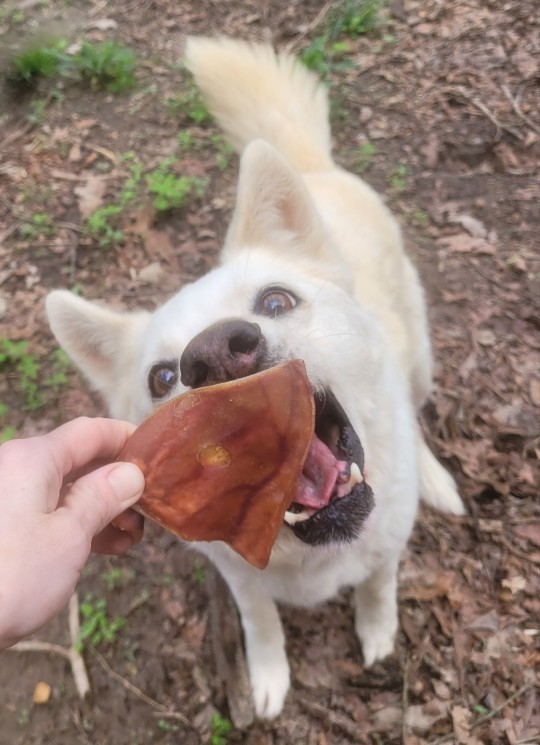
Sorry for the butt-reblog, folks, baffled as to what happened there. Here, have a picture of Bolt. He's 12 this year and still in excellent health. We found out via a sibling who was Embarked that he is a mix of husky, Australian cattle dog, and sheltie (in that order), so that's kinda neat.
5 notes
·
View notes
Text

I feel like I've referenced a lot of projects over the past year, but haven't POSTED a lot of projects. So anyway, here is our most recent work: bioactive enclosures for arboreal geckos, and the shelving unit that houses them. We just finished up today, so there are still supplies stashed underneath, and the plants are just babies, but I'm really looking forward to seeing these grow out and house happy lizards.
Our objective for next week is enclosure upgrades for all beardies and leopard geckos, as well as moving our goldfish from a three tiered hundred-gallon stock tank system to a 300g stock tank with improved filtration so that they have the company of conspecifics, something that's been bugging me for a while. We are going on a trip with family in April and per usual have a TON of work to do between then and now, but I think we will get there - and if not we will come back refreshed and ready to tackle more projects to elevate conditions for our residents.
ACS has been on an intake freeze for three years, with only a handful of animals coming into our care in that time. However, we still have a large number of sanctuary animals who will be with us for life. Over 60 species call ACS home, and now that we are no longer actively rescuing, our top priority is providing a higher standard of care. I was suffering pretty severe burn-out at the time I closed intakes, and it's been very healing to reignite my joy for excellent animal husbandry and enrichment.
#animal rescue#habitat#enclosure#bioactive#lizards#reptiles#herp#herps#around the rescue#animal husbandry
5 notes
·
View notes
Text

Let's talk about senior pets and age-related cognitive decline.
We don't know The Lady Sif's exact age, but she is definitely in her teens. Last year, we noticed that she was losing weight and took her to the vet to see if she was developing any of the usual suspects in aging felines (diabetes, kidney disease, hyperthyroidism). Nothing came back indicating illness (though she has gone deaf), so we started observing the cats more closely at feeding time to see if she was being out-competed by more aggressive animals. What we discovered, however, was that she was wandering away from the food after only a few mouthfuls of her own volition.
We started isolating her at feeding time and placed her on a more calorie dense formula. However, even feeding on her own, she would leave the food bowl to aimlessly wander and vocalize. When redirected back to the food, she would promptly go back to eating, then repeat the wandering behavior moments later. With daily supervised feedings continually reintroducing her food whenever she became distracted, she quickly returned to healthy body condition, and showed coat improvement.
We think, and our vet agrees, that what we are likely seeing is age-related cognitive decline, which is in many ways similar to dementia in humans. Elderly pets in cognitive decline will often show behaviors such as disorientation, changes in sleep habits, changes in feeding habits, increased vocalization, quickly becoming disengaged with play/attention, temperament changes, and house soiling.
In addition to the potential impact on pet health, these changes can be frustrating, frightening, and inconvenient for owners. Having a pet live into old age is a blessing, but it often comes with challenges that require lifestyle changes for pet and caregiver alike. I openly admit that some days, when I'm exhausted and in a hurry, I find supervised feeding times with constant reminders that there is food available to be very annoying. It's okay to have those feelings as long as you continue to provide for your pet's changing needs.
What can you do about dementia in companion animals? Much as is the case with humans, the condition has no magic cure, but symptom management can make things easier on both pet and owner. Creating and sticking to a daily routine, having a stable lighting schedule, providing additional litter boxes and resting places, avoiding major changes to the environment (orientation of furniture, for example), providing a healthy diet rich in brain-supporting nutrients, and engaging in forms of enrichment that require thinking (food puzzles, interactive play) can all provide a measure of relief.
And of course, patience, understanding, and accommodation are crucial. Your bond with your pet in cognitive decline may change as their behavior and disposition changes as well, but at the heart of that bond is love, and as long as you hold onto that, you can allow your pet to age with compassion and dignity.
#animal rescue#cat#cats#aging#senior pets#senior cat#veterinary medicine#cognitive decline#pet health#my cats
7 notes
·
View notes
Text
We have been in project mode for weeks now; we built a large unit to hold bioactive enclosures for some of our arboreal geckos, a new tortoise table for the younger red-footed tortoises, and are halfway through the process of predator-proofing and building sumps for two 300g stock tanks (one for goldfish, one for a snapping turtle). Next on the agenda is setting up housing for a pair of ornate wood turtles we recently took in, for when they are done in quarantine.
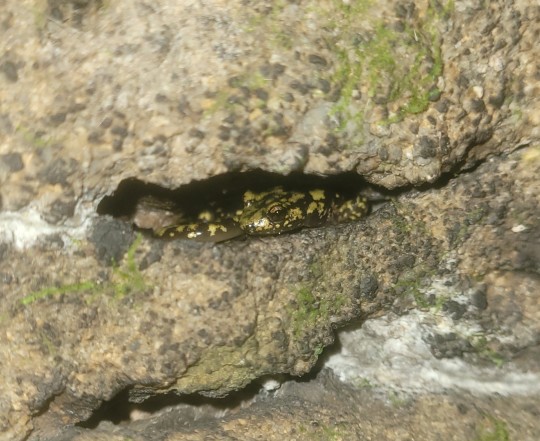
With so much going on, there has been a dire lack of leisure time, so today we indulged in morning salameander (a walk specifically to find salamanders) in the Tuscaloosa area. Alabama has a richness of salamander diversity, with 43 species calling our state home. One we haven't seen before was our mission for today's outing: the green salamander.
Green salamanders are found in only a small portion of Alabama, where they are listed as a species of concern, and are habitat specialists. They are found almost exclusively in the narrow crevasses in moist, well-shaded rocky outcrops (as the one pictured so nicely demonstrates). We had an excellent day for searching and spotted five individuals, as well as three slimy salamanders and one red-backed salamander. It is always heartening to see a robust amphibian population, as amphibians are facing global decline due to a combination of disease, habitat loss, and climate change.
#alabama wildlife#wildlife#amphibian#amphibians#salamander#salamanders#herping#salameander#green salamander
3 notes
·
View notes
Note
You're in central alabama? Is there a way I could visit and support you financially? I've always loved this blog, and I'm looking for reasons to venture north (I live in Gulf Shores.) If you don't allow visitors (I completely understand) I'd love to be able to donate.
We are indeed in Central AL, but because the rescue is operated out of our own home and one of my partners' homes is also on the property, we unfortunately do not allow visitors. As we are no longer doing intakes (with rare exceptions here and there), I would feel strange accepting monetary donations, but would gladly accept supply donations. We have a supply wish list on Amazon, and can always use gift cards to sites/stores like Chewy, Exotic Nutrition, Dubia.com, Tractor Supply, and Lowes, as well as most major pet stores.
Thank you so much for your continued support of our blog and for your kind offer to donate!
6 notes
·
View notes
Text

Yesterday was a tad stressful. Okotto, one of our long-time residents, has recently been experiencing weight loss and occasional vomiting. We took her to see our exotics vet, which is always a feat with an animal that is heavy, loud, and uncooperative, though as one of our smallest pigs she was easier to wrangle than some. To be thorough, she was given a physical exam, x-rays, a full blood panel, and a fecal. This required mild sedation, as pigs are difficult patients, and less tame pigs even more so. The conclusion reached was that Okotto is in excellent health, but is likely older than our estimate (we had her at ten based on how long we had her and the age reported by her previous owner), and in addition to probable age-related decline in body condition may be vomiting due to inadequately chewed food from substantial dental wear. We will be supplementing her diet with calorie-dense foods and soaking the dry matter to see if there is any improvement.
The visit proved expensive for a diagnosis of "old," but I'd rather expensive good news than expensive bad news, and I feel fortunate that I can afford to give our residents a high standard of veterinary care. I will say that this visit underscores two points: one, ensuring that you have access to a qualified exotics or livestock vet before embarking on the ownership of a less conventional pet, and also that you should do what I haven't been able to due to the sheer number of animals we have worked with historically: invest the time and effort into acclimating your pets to intrusive/extensive handling so that vet visits are less difficult and stressful for all parties involved. A fractious pet makes veterinary care more difficult and more dangerous for patient and staff alike.
I feel this is an area of opportunity for pet owners of every stripe. Best practices in zookeeping include conditioning animals to accept various forms of handling that facilitate easier veterinary care, yet even dealing with far more biddable domesticated species like cats and dogs, we often fail to prepare our pets for routine vet care (and grooming). The stress animals experience at the vet tends to become a vicious cycle; the first bad encounter sets a negative tone for future visits, and the more a frightened animal struggles, the more difficult care becomes, and the more likely injury to vet staff is to occur. Conversely, animals who are introduced to positive handling experiences from a young age make for calmer, more cooperative patients with better outcomes.
We owe it to our animals and our veterinary staff to set the stage for success. So do yourself, your pets, and your vets a big favor: prepare your pet for the vet before it even has its first visit.
#animal rescue#pig#pigs#mini pig#mini pigs#pot belly pig#potbellied pig#exotic pets#animal husbandry#vet med#exotics vet#animal training
6 notes
·
View notes
Text
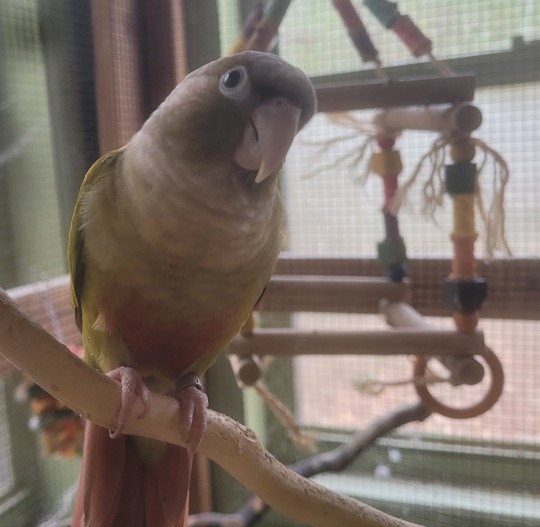
Cypress looks very sweet in this soft lighting, but I can assure you that he is contemplating violence at all times. He and Birch (and the rest of our flock) are enjoying the freedom of the aviaries we built about a year ago. Now that those flight muscles are well developed, he's in excellent form for dive-bombing bite attacks.
6 notes
·
View notes
Text


I keep saying I'm going to get back to posting regularly, and then spend all of my writing energy on fiction instead. Maybe I need to accept that if I don't have it in me to write long informative posts, my audience still might like to see things like my turkey, Strawberry Preserves, being cuddly.
13 notes
·
View notes
Text

I guess I should formally introduce Henwen now that she is a full-fledged member of our piggie crew.
A few years back, a dear friend was having a battle about zoning and needed a place for their two pigs to stay, so we agreed to take them while it got sorted out, setting up an area for them apart from our main herd. This friend then had an unprecedented opportunity to get out of a bad situation and start over fresh in another state (far away), so the pigs remained with us. I've loved and cared for them as my own ever since.
One of the two pigs was very elderly (blind and deaf to boot, hence keeping them in their own space) and passed away earlier this year, leaving her younger friend alone. As you know, we also lost Nago about two years ago, leaving Ino alone. I've been wanting to introduce the two solo girls since neither are a good fit for the main herd, but have been terribly busy with work. I'm away in NY visiting family starting today, and I simply can't go on vacation without embarking on a big project beforehand, so I decided we finally needed to move on this last weekend to make things extra hectic before the trip.
Using one existing wall as a divider, we doubled the size of Ino's enclosure to get the ball rolling on introducing these two; once they are together, they'll have the entire space to share. It's going to have to be a soft intro/long acclimation period, because for a little pig Ino has a BIG attitude, but I'm confident they'll become friends.
... Right now Ino and her mustache are very cranky, though.

#animal rescue#pig#pigs#mini pig#mini pigs#pot belly pig#pot bellied pig#potbellied pig#livestock#pet pig
13 notes
·
View notes
Text

Sometimes when I'm working in the front room I get the most eerie feeling that I'm being watched...
3 notes
·
View notes
Text

I have been bad about updating Bolt's Instagram, and passing out chews in general. My goal for October, since I will be away for Halloween and unable to make the usual "zombie stew" organ meat meal for the dogs, is to just dole out a bunch of stuff from my chews/treats stash throughout the month.
All of the dogs are getting on in years; my youngest is eight, and my oldest will be thirteen a few months. Bolt is actually coming up on twelve this January. So really, why not be more generous with toys and treats and attention? If there is one thing rescue work has taught me, it is that you never know how much time you have with an animal, and delaying plans to improve enclosures, provide more enrichment, give out toys/treats, or spend quality time together is a recipe for regret - because sometimes that "soon" never comes.
Anyway, Bolt is very happy about his Instagram revival, as you can see.
6 notes
·
View notes
Text

If you find it annoying when dogs beg, probably don't get goats. The moment I step out front I have 13 of these bad boys following me along the fence line screaming and giving me this look because they want a lil treat.
8 notes
·
View notes
Text
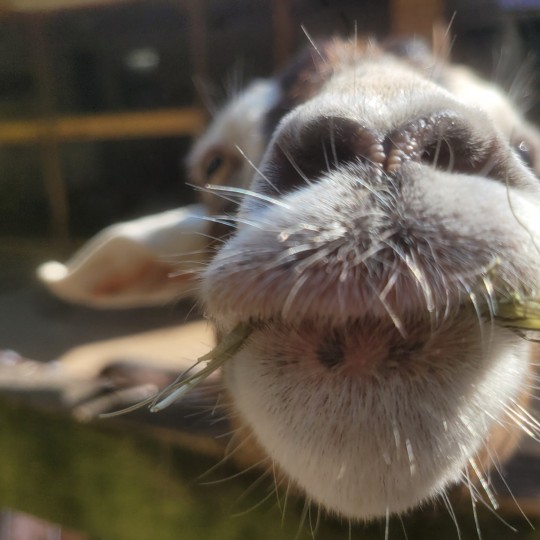
Portrait of Kipo using her one and only brain cell to determine if my cell phone is food this time. She is certain that some day it will be.
1 note
·
View note
Text
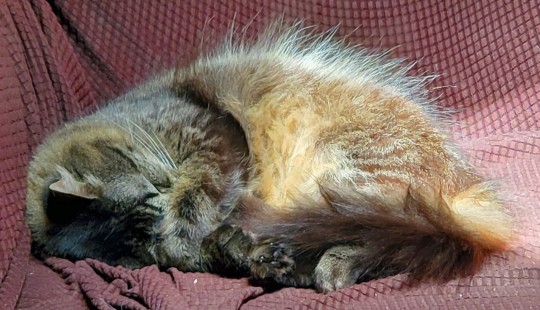

Compelling argument that my cat Fury (above) is actually a porcupine. What even are those long, pale guard hairs?
6 notes
·
View notes
Text
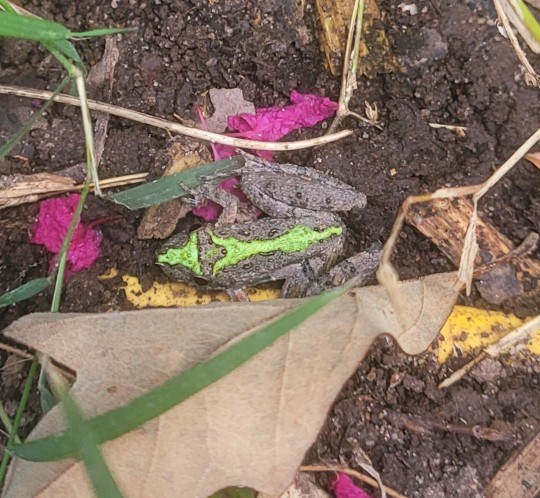
I've been in a bit of a rut for motivation lately after a brief illness, so I haven't generated any new content on here. But I think this stunning cricket frog is worth sharing. This is a very cool little species that comes in a huge array of colors, though I find the ones with this bright green dorsal pattern especially striking.
#animal rescue#alabama wildlife#wildlife#native wildlife#amphibian#amphibians#frog#frogs#cricket frog#eastern cricket frog
6 notes
·
View notes
Text

I've been away from Tumblr for so long that I forgot about all of the interesting goings-on that I DIDN'T share here. FB memories had been reminding me of some, so I'll share the fun ones on here.
Anyway, about a year and a half ago, we were called on as transporters for a capybara in southern AL from his current home to a rescue in Texas.* My chronic pain issues have reached a severity that limits my ability to go on long transports these days, but my spouse gave the little guy a lift and used the trip as an excuse to do some bird photography in Texas. Just thought you'd like to see what a capybara looks like in the back of our car. This individual was actually on the smaller size for an adult of the species.
* This was a legal transport with the appropriate paperwork to move the animal between states, always check your laws when transferring animals across state lines - not just exotics, too, some states require health certificates from a veterinarian for dogs/cats/domesticated livestock.
5 notes
·
View notes